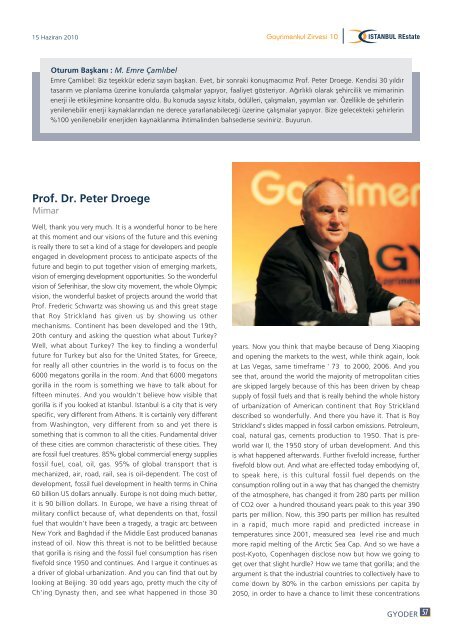Zirve Eki - ISTANBUL REstate
Zirve Eki - ISTANBUL REstate
Zirve Eki - ISTANBUL REstate
Create successful ePaper yourself
Turn your PDF publications into a flip-book with our unique Google optimized e-Paper software.
15 Haziran 2010<br />
Gayrimenkul <strong>Zirve</strong>si 10<br />
Oturum Baflkan› : M. Emre Çaml›bel<br />
Emre Çaml›bel: Biz teflekkür ederiz say›n baflkan. Evet, bir sonraki konuflmac›m›z Prof. Peter Droege. Kendisi 30 y›ld›r<br />
tasar›m ve planlama üzerine konularda çal›flmalar yap›yor, faaliyet gösteriyor. A¤›rl›kl› olarak flehircilik ve mimarinin<br />
enerji ile etkileflimine konsantre oldu. Bu konuda say›s›z kitab›, ödülleri, çal›flmalar›, yay›mlar› var. Özellikle de flehirlerin<br />
yenilenebilir enerji kaynaklar›ndan ne derece yararlanabilece¤i üzerine çal›flmalar yap›yor. Bize gelecekteki flehirlerin<br />
%100 yenilenebilir enerjiden kaynaklanma ihtimalinden bahsederse seviniriz. Buyurun.<br />
Prof. Dr. Peter Droege<br />
Mimar<br />
Well, thank you very much. It is a wonderful honor to be here<br />
at this moment and our visions of the future and this evening<br />
is really there to set a kind of a stage for developers and people<br />
engaged in development process to anticipate aspects of the<br />
future and begin to put together vision of emerging markets,<br />
vision of emerging development opportunities. So the wonderful<br />
vision of Seferihisar, the slow city movement, the whole Olympic<br />
vision, the wonderful basket of projects around the world that<br />
Prof. Frederic Schwartz was showing us and this great stage<br />
that Roy Strickland has given us by showing us other<br />
mechanisms. Continent has been developed and the 19th,<br />
20th century and asking the question what about Turkey?<br />
Well, what about Turkey? The key to finding a wonderful<br />
future for Turkey but also for the United States, for Greece,<br />
for really all other countries in the world is to focus on the<br />
6000 megatons gorilla in the room. And that 6000 megatons<br />
gorilla in the room is something we have to talk about for<br />
fifteen minutes. And you wouldn't believe how visible that<br />
gorilla is if you looked at Istanbul. Istanbul is a city that is very<br />
specific, very different from Athens. It is certainly very different<br />
from Washington, very different from so and yet there is<br />
something that is common to all the cities. Fundamental driver<br />
of these cities are common characteristic of these cities. They<br />
are fossil fuel creatures. 85% global commercial energy supplies<br />
fossil fuel, coal, oil, gas. 95% of global transport that is<br />
mechanized, air, road, rail, sea is oil-dependent. The cost of<br />
development, fossil fuel development in health terms in China<br />
60 billion US dollars annually. Europe is not doing much better,<br />
it is 90 billion dollars. In Europe, we have a rising threat of<br />
military conflict because of, what dependents on that, fossil<br />
fuel that wouldn't have been a tragedy, a tragic arc between<br />
New York and Baghdad if the Middle East produced bananas<br />
instead of oil. Now this threat is not to be belittled because<br />
that gorilla is rising and the fossil fuel consumption has risen<br />
fivefold since 1950 and continues. And I argue it continues as<br />
a driver of global urbanization. And you can find that out by<br />
looking at Beijing. 30 odd years ago, pretty much the city of<br />
Ch'ing Dynasty then, and see what happened in those 30<br />
years. Now you think that maybe because of Deng Xiaoping<br />
and opening the markets to the west, while think again, look<br />
at Las Vegas, same timeframe ' 73 to 2000, 2006. And you<br />
see that, around the world the majority of metropolitan cities<br />
are skipped largely because of this has been driven by cheap<br />
supply of fossil fuels and that is really behind the whole history<br />
of urbanization of American continent that Roy Strickland<br />
described so wonderfully. And there you have it. That is Roy<br />
Strickland's slides mapped in fossil carbon emissions. Petroleum,<br />
coal, natural gas, cements production to 1950. That is preworld<br />
war II, the 1950 story of urban development. And this<br />
is what happened afterwards. Further fivefold increase, further<br />
fivefold blow out. And what are effected today embodying of,<br />
to speak here, is this cultural fossil fuel depends on the<br />
consumption rolling out in a way that has changed the chemistry<br />
of the atmosphere, has changed it from 280 parts per million<br />
of CO2 over a hundred thousand years peak to this year 390<br />
parts per million. Now, this 390 parts per million has resulted<br />
in a rapid, much more rapid and predicted increase in<br />
temperatures since 2001, measured sea level rise and much<br />
more rapid melting of the Arctic Sea Cap. And so we have a<br />
post-Kyoto, Copenhagen disclose now but how we going to<br />
get over that slight hurdle? How we tame that gorilla; and the<br />
argument is that the industrial countries to collectively have to<br />
come down by 80% in the carbon emissions per capita by<br />
2050, in order to have a chance to limit these concentrations<br />
GYODER 57


